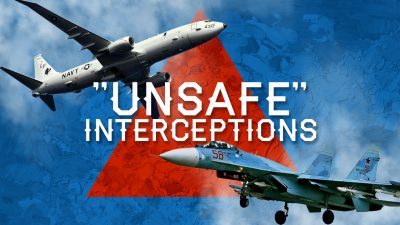Video: Russian Fighter Jets Buzz US Spy Planes Off Syrian Coast

On April 20, gunmen attacked a vehicle of the US-led coalition moving along the road near the village of Roueished in the province of al-Hasakah. Syrian state media reported that the vehicle was destroyed and several US service members were injured in the attack. The US-led coalition has not officially commented on these claims yet.
This became the second report of this kind, which appeared in media this month. On April 6, Hezbollah-linked al-Mayadeen TV said that militants killed a US soldier and several members of the Kurdish-led Syrian Democratic Forces on the eastern bank of the Euphrates. If these attacks really took place, it is likely that the supposed US soldiers killed in the attacks were in fact US-linked private military contractors. Therefore, the Pentagon does not report them as casualties among US personnel.
Syrian security forces seized weapon caches belonging to radical militants near Damascus and Quneitra. The seized weapons and equipment included a Malutka anti-tank missile, several RPG rounds, machine guns, mortars, hand grenades, satellite broadcasting and telecommunications devices, medical equipment and even several cars.
The Damascus countryside and the southern part of Syria have been for long time formally liberated from terrorists. Nonetheless, government forces regularly face various kinds of terrorist activity in these areas. Terrorist cells operating there receive support from the militant held parts of northern and western Syria, and the terrorist threat cannot be fully removed as long as these areas remain in the hands of radical militant groups protected by Turkey.
On April 19 and April 15, Russian fighter jets intercepted US Navy P-8A Poseidon spy planes off the Syrian coast. The increased US reconnaissance activity in the eastern Mediterranean often comes ahead and ahead of the escalation of the conflict. It is possible the Washington leadership also believes that the military situation in Greater Idlib also has chances to explode in the near future.
Since the signing of the March 5 de-escalation agreement in Moscow, Turkey and Russia have achieved no progress in its implementation besides the establishing ceasefire regime in southern and eastern Idlib. Hayat Tahrir al-Sham and other radical groups used the pause to fortify their positions in the region. Turkey also used this time to deploy additional troops and equipment there. Ankara’s actions demonstrate that it is in fact allied with al-Qaeda-linked groups in Idlib. So, its forces are likely preparing for a new confrontation with the Syrian Army.
*
Note to readers: please click the share buttons above or below. Forward this article to your email lists. Crosspost on your blog site, internet forums. etc.
Support South Front in its endeavors. If you’re able, and if you like our content and approach, please support the project. Our work wouldn’t be possible without your help: PayPal: [email protected] or via: http://southfront.org/donate/ or via: https://www.patreon.com/southfront

